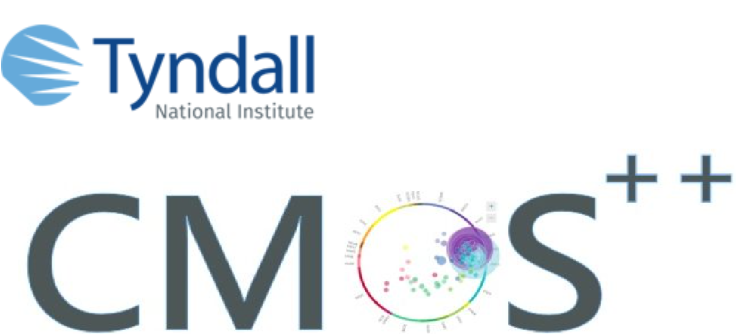Direct growth of transition metal dichalcogenides over large areas within the back-end-of-line (BEOL) thermal budget limit of silicon integrated circuits is a significant challenge for 3D heterogeneous integration. At Tyndall, repeatable, rapid, uniform, and continuous MoS2 direct growth films of ~1–10 nm thickness have been achieved by chemical vapour deposition at low temperatures (350–550 °C).
The morphology, material quality and growth rates were found to be substrate dependent, as illustrated in Figure 1 for the growth on silicon-SiO2, sapphire and Alumina coated sapphire.

Figure 1. (a) 550/450/350 °C CVD-grown MoS2 on SiO2/Si substrates, showing a lighter blue colour at decreased temperatures, likely due to increasing disorder and oxygen incorporation. Such coupons are placed throughout the chamber demonstrating that uniform and continuous film deposition is achievable across a 300 mm diameter. (b) Different MoS2 thicknesses grown on SiO2/Si and sapphire substrates, where colours go from almost transparent to increasingly darker with increasing thickness. Repeatability is excellent. The thicknesses shown are nominal values assuming a linear growth rate. (c-e) HR-XTEM micrographs show polycrystalline and layered MoS2 (550 °C, 1 × H2S, 2.5 hours) on SiO2/Si, sapphire, a-Al2O3 (~30 nm)/sapphire. (f) Electron diffraction pattern confirms the formation of polycrystalline MoS2, where [100] and [110] are dominant orientations. (g) Plan-view HR-TEM of MoS2 initially grown on SiO2/Si substrate and transferred onto a TEM grid, showing the hexagonal structures of CVD-grown MoS2. (h) FFT filtering produces a clear image of the hexagonal structures. [1]
The production of large area MoS2 direct growth within a BEOL thermal budget is key to the integration of this material to future technology. To illustrate the potential of the grown material a range of device applications including vertical transport memristors, gas sensors and self- switching diodes have been fabricated and tested.
Memristor structures (Au/MoS2/Au), were shown to exhibit switching between the high-low resistive states with a stable memory window of 105 and a retention time > 104 seconds. Although not yet optimised, the switching set and reset voltages in these memristors demonstrate a significant reduction compared to memristors fabricated from pristine, single-crystalline MoS2 at higher temperatures, thereby reducing the energy needed for operation [1].
Interdigitated electrode-based gas sensors fabricated on MoS2 films were shown to possess excellent selectivity and sub-ppm sensitivity to NO2 gas, with a notable self-recovery at room temperature [1].
MoS2 in diode structures (MoS2/Al2O3/Hi-Res Si) was also found to behave as a transparent piezoelectric material in the near infrared spectral region and as a strain-induced ferroelectric material with a d33 piezoelectric coefficient of 3–10 pm/V. This enabling the use as a lateral memristor and demonstrating potential as a photodetector in the visible spectrum (responsivities as high as 17 A/W) [2].
References
- https://iopscience.iop.org/article/10.1088/2053-1583/abc460/
- https://doi.org/10.1016/j.physe.2020.114451

